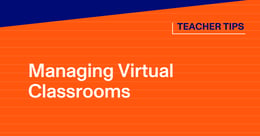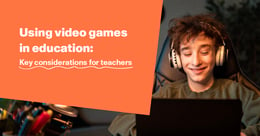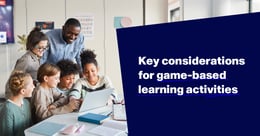
7 tips to blend game-based activities with other teaching strategies
What if everything in the classroom was a game?
Seem like a bit of a stretch? Sure, not every learning process is well suited for game-based learning—but there’s immense potential for integrating game-based activities into traditional learning approaches.
We’ll explore how teachers can integrate game elements into a wide variety of teaching strategies to help drive engagement, foster learning, and achieve learning objectives.
The benefit of learning through games
As teachers strive to strike a balance between extrinsic and intrinsic motivation, game elements can reintroduce a sense of fun and play to the classroom. Light competition and artificial points may be external rewards, but they foster a sense of accomplishment that comes with less pressure than grades or other external progress indicators.
Game-based learning can be a great complement to other teaching strategies
As an educational technique, game-based learning can sometimes seem like an all-or-nothing endeavor: Either students play learning games to explore and practice a new concept, or they participate in more traditional instructional methods.
In reality, game-based activities can be woven into a wide variety of active learning strategies. These kinds of integrated learning experiences can be even richer and more engaging than techniques that fall solely on one side of the equation or the other.
1. Bring station rotations into open-world game environments
Increasingly, students and their teachers will have to navigate both physical places and digital environments. Video games like Minecraft and its popular education edition provide teachers with a new venue for setting up virtual stations where students can hone their skills: a fun twist on a classic educational strategy.
An Edutopia article about using Minecraft to teach writing illustrates just how teachers can pull off this sort of game-based activity. Although this particular example was first spurred by the change to distance and blended learning during the pandemic, there are still many reasons to use Minecraft and other classroom games for station rotation during in-person learning. After all, as educational technology professor Dr. Matthew Farber notes in the article, this game-based environment offers a lot of room for imagining new possibilities.
“With the Minecraft lessons, students can change the worlds, and teachers can, too,” said Farber. “Each of these worlds can be played as they are or remixed by teachers.”
[READ: “Game-based learning activities by grade level”]
2. Don’t forget what analog game-based activities can do for learning
Much of the recent buzz around game-based learning can be attributed to the rising popularity of digital games. In such a context, bringing games into the classroom seems to have obvious implications for science education and for facilitating interest in STEM fields such as computer science. And in turn, young learners can see an immediate inroad to possible pathways in higher education.
But the history of game-based learning in education actually points toward a broader variety of contemporary applications. An Edutopia article on enhancing learning through gameplay also suggests that classic board games and contemporary party games can serve as potential methods for bringing casual collaboration and competition into more conventional lesson plans.
3. Hook students’ interest by reading about popular games
Learners love it when they get the chance to study what they’re already interested in, and for many students, online games are a big point of fascination. In a roundup of nonfiction warmup activities from The New York Times, students are invited to preview an article about Among Us. The prompt encourages them to read a quote from a teenager before contemplating how they would write—for an adult audience—about a young person’s perspective toward the game.
[READ: “Resource roundup: Daily warmup activities to try with Paper™”]
4. Drive home an overarching lesson by using an engaging activity
Digital game-based learning doesn’t just have to be about shoring up individual skills or fostering overall learner engagement. Sometimes, these learning activities can be an effective way to facilitate a change in perspective that can serve students well for a long time to come. Take NewsFeed Defenders for example. Students can develop media literacy by trying their hand at social media moderation in a fictional setting.
[READ: “The role of video games in education: Tips for teachers”]
5. Put your spin as a teacher on the day’s cultural touchstones
Game-based activities can be a great way to tap into the trending topic du jour. For example, March Madness-inspired literary brackets can help students reengage with ELA learning outcomes from across the year. But there’s no limit to what educators in all classrooms could do to get students playing a game that ties into the world around them. Educators can coordinate their efforts during professional development sessions to ensure they’re finding creative ways to uphold consistent themes throughout the school day.
[READ: “8 inspiring Pi Day activities from educators who make math fun”]
6. Make in-person excursions an interactive game—for students and teachers alike
Scavenger hunts are a time-honored way to spur student learning during field trips, but are they everything they could be? Educators may be interested to discover they can tweak the game design of these activities to make scavenger hunts even more meaningful. A blog post from an education specialist at the National Museum of American History encourages students and educators to take unscripted field trips of the space: Learners find artifacts that resonate with them and connect these objects to broad, open-ended questions—a process that fosters engaging conversations.
7. Use educational games to reinforce key skills
Independent practice, review, and repetition can be crucial for ensuring specific learning objectives stick. Through fun games that are aligned with relevant standards, students can practice core concepts in a lighthearted, entertaining atmosphere. For example, with Paper Missions, independent practice in math gets a whole lot more exciting. Students can engage with clever storylines and interesting characters as they crunch numbers and manipulate variables. As an added benefit, learners in participating districts can log in to specifically work on concepts tied to statewide testing standards.
Use game-based activities to achieve today’s educational goals
When deployed for educational purposes, game-based activities can be leveraged alongside a wide variety of other instructional strategies. As teachers search for new ways to drive student engagement, facilitate teamwork, and help learners develop 21st-century skills, games will have a big role to play.
Find out what other topics stand out for today’s education leaders. Download our free ebook, “K-12 leadership guide: 8 priorities for 2023.”






